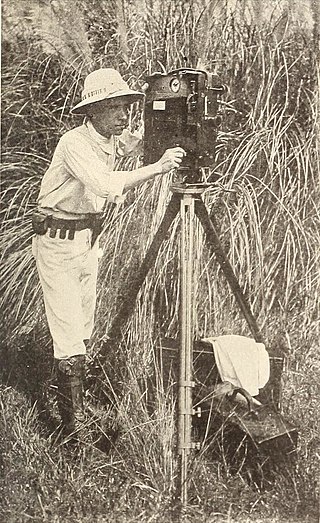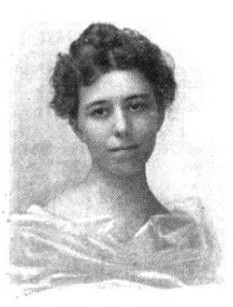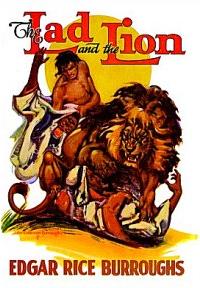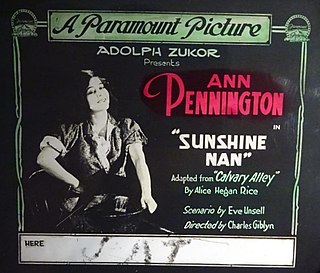
The Kalem Company was an early American film studio founded in New York City in 1907. It was one of the first companies to make films abroad and to set up winter production facilities, first in Florida and then in California. Kalem was sold to Vitagraph Studios in 1917.

George K. Hollister was an American pioneer cinematographer.

Alice Hegan Rice, also known as Alice Caldwell Hegan, was an American novelist. Her 1901 novel Mrs. Wiggs of the Cabbage Patch became a play and four films.

William Pickford, 1st Baron Sterndale, was a British lawyer and judge. He served as a Lord Justice of Appeal between 1914 and 1918, as President of the Probate, Divorce and Admiralty Division between 1918 and 1919 and as Master of the Rolls between 1919 and 1923.

Paul Joseph Kilday was a Democratic member of the United States House of Representatives from Texas, representing the 20th district from January 3, 1939, to September 24, 1961, before serving as a Judge of the United States Court of Military Appeals.

Amarilly of Clothes-Line Alley is a 1918 American silent romantic comedy film starring Mary Pickford that was directed by Marshall Neilan and written by Frances Marion based upon a novel by Belle K. Maniates.

Little Annie Rooney is a 1925 American silent comedy-drama film starring Mary Pickford and directed by William Beaudine. Pickford, one of the most successful actresses of the silent era, was best known throughout her career for her iconic portrayals of penniless young girls. After generating only modest box office revenue playing adults in her previous two films, Pickford wrote and produced Little Annie Rooney to cater to silent film audiences. Though she was 33 years old, Pickford played the title role, an Irish girl living in the slums of New York City.

M'Liss is a 1918 American silent comedy drama film directed by Marshall Neilan, written by Frances Marion and based on a Bret Harte story. The film was made previously in 1915 and was remade again in 1922 as The Girl Who Ran Wild, starring Gladys Walton. Another same-titled remake was released in 1936, starring Anne Shirley.

Lovey Mary is a 1926 American comedy-drama film directed by King Baggot, with Bessie Love in the title role. It is based on the 1903 novel of the same name by Alice Hegan Rice, a sequel to Rice's Mrs. Wiggs of the Cabbage Patch. It was distributed by Metro-Goldwyn-Mayer.

The Test of Honor (1919) was an American silent film drama produced by Famous Players–Lasky, released by Paramount, directed by John S. Robertson, and starring John Barrymore. Considered the actor's first drama movie role after years of doing film comedies and farces. It is based on author E. Phillips Oppenheim 1906 novel The Malefactor.

The Lad and the Lion is an adventure novel by American writer Edgar Rice Burroughs, written in February 1914. His working title for the piece was "Men and Beasts." It was first published as a three-part serial in All-Story Weekly in the issues for June 30, July 7, and July 14, 1917. The story was the first by Burroughs adapted to film, the movie appearing about the same time as the print serial. Despite this distinction, the story did not appear in book form for over twenty years; only after a remake of the film appeared was the first book edition published, by Burroughs's own publishing firm, Edgar Rice Burroughs, Inc., in February 1938. The text was apparently expanded for book publication, as certain incidentals of the story reflect the political situation of Europe in the late 1930s rather than the mid-1910s. The book was reprinted by Grosset & Dunlap in 1939 and Canaveral Press in 1964. The first paperback edition was issued by Ballantine Books in September 1964, with a second appearing from Ace Books in May 1974, reprinted in June 1982.

Mile-a-Minute Kendall is a 1918 American silent drama film directed by William Desmond Taylor and released by Paramount Pictures. Jack Pickford plays the title role, a wealthy, rakish young man who falls for a gold digger. The "beautiful but unscrupulous fortune hunter" who tempts Kendall is played by Lottie Pickford, Jack's sister; a contemporary review in Variety noted that "the idea of a sister 'vamping' her own brother is not exactly palatable." Louise Huff plays the "good girl" in the story.

The Walking Dead: The Fall of the Governor is a two-part post-apocalyptic horror novel written by Robert Kirkman and Jay Bonansinga. Part one was released on October 8, 2013 and part two was released March 4, 2014. The novel is a spin-off of Kirkman's series of graphic novels and explores the back-story of one of the series' most infamous characters, The Governor. The Fall of the Governor is the third and final book in a trilogy of novels, following The Walking Dead: Rise of the Governor and The Walking Dead: The Road to Woodbury.

Sunshine Nan is a surviving 1918 American silent comedy-drama film starring Ann Pennington and directed by Charles Giblyn. It is based on the novel Calvary Alley by Alice Hegan Rice. It was produced by Famous Players–Lasky and distributed by Paramount Pictures.

Seventeen is a lost 1916 American comedy silent film directed by Robert G. Vignola and written by Booth Tarkington and Harvey F. Thew. It is based on Tarkington's novel of the same name which was published earlier the same year. The film stars Louise Huff, Jack Pickford, Winifred Allen, Madge Evans, Walter Hiers, and Dick Lee. The film was released on November 2, 1916 by Paramount Pictures.

Jack and Jill is a 1917 American Western silent film directed by William Desmond Taylor and written by Gardner Hunting and Margaret Turnbull. The film stars Jack Pickford, Louise Huff, Leo Houck, Don Bailey, J.H. Holland, and Jack Hoxie. The film was released on November 12, 1917, by Paramount Pictures.

Sandy is a 1918 American silent drama film directed by George Melford, and written by Alice Hegan Rice and Edith Kennedy. The film stars Jack Pickford, Louise Huff, James Neill, Edythe Chapman, Julia Faye, and George Beranger. The film was released on July 14, 1918, by Paramount Pictures.
Kentucky literature did not become well known until the late 19th century, when authors such as James Lane Allen, John Fox, Jr., Alice Hegan Rice, and Annie Fellows Johnston brought light to the state's rich history and culture. As their literary works grew in popularity around the country and world, others began to take notice of all types of Kentucky literature, including works of fiction, nonfiction, poetry and the historical novel.

Mrs. Wiggs of the Cabbage Patch, is an 1903 comedy by American author Anne Crawford Flexner. It was based on two books by Alice Hegan Rice, Mrs. Wiggs of the Cabbage Patch (1901) and Lovey Mary (1903). It has three acts and two settings, all within the "Cabbage Patch", an impoverished neighborhood on the fringes of Louisville, Kentucky. The character-driven play covers three weeks time and has multiple storylines, including an ill-starred mail-order marriage, two refugees from an orphanage, the return of a long-lost husband, and a handful of young romances.


















